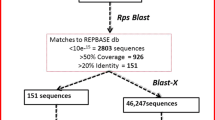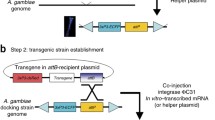Abstract
Three distinct types of Tc1‐family transposable elements have been identified in the malaria vector, Anopheles gambiae. These three elements, named Tsessebe, Topi and Tiang, have the potential to encode transposases that retain most of the conserved amino acids that are characteristic of this transposon family. However, all three are diverged from each other by more than 50% at the nucleotide level. Full‐length genomic clones of two types, Topi and Tsessebe, have been isolated and fully sequenced. The third, Tiang, is represented only by a 270 bp, PCR‐amplified fragment of the transposase coding region. The Topi and Tsessebe elements are 1.4 kb and 2.0 kb in length, respectively, and differ in the length of their inverted terminal repeats (ITRs). The Topi elements have 26 bp ITRs, whereas the Tsessebe clones have long ITRs ranging in length from 105 to 209 bp, with the consensus being about 180 bp. This difference is due primarily to variation in the length of an internal stretch of GT repeats. The copy number and location of these elements in ovarian nurse cell polytene chromosomes varies greatly between element subtypes: Topi elements are found at between 17–31 sites, Tsessebe at 9–13 and at 20 euchromatic sites, in addition to several copies of these elements in heterochromatic DNA. The copy number and genomic insertion sites of these transposons varies between A.gambiae strains and between member species of the A.gambiae complex. This may be indicative of transpositionally active Tc1‐like elements within the genome.
Similar content being viewed by others
References
Avancini, R.M.P., K.K.O. Walden & H.M. Robertson, 1996. The genomes of most animals contain multiple members of the Tc1 family of transposable elements. Genetica 98: 131–140.
Benedict, M.Q. & H. Chang, 1996. Rapid isolation of anopheline mosquito eye-colour mutants, based on larval colour change. Med. Vet. Entomol. 10: 93–96.
Coates C.J., N. Jasinskiene, L. Miyashiro & A.A. James, 1998. Mariner transposition and transformation of the yellow fever mosquito, Aedes aegypti. PNAS USA 95: 3748–3751.
Collins, F.H., M.A. Mendez, M.O. Rasmussen, P.C. Mehaffey, N.J. Besansky & V. Finnerty, 1987. A ribosomal RNA gene probe differentiates member species of the Anopheles gambiae complex. Am. J. Trop. Med. Hyg. 37: 37–41.
Coluzzi, M., A. Sabatini, V. Petrarca & M.A. Di Deco, 1979. Chromosomal differentiation and adaptation to human environments in the Anopheles gambiae complex. Trans. R. Soc. Trop. Med. Hyg. 73: 483–497.
Doak, T.G., F.P. Doerder, C.L. Jahn & G. Herrick, 1994. A proposed superfamily of transposase genes: Transposon-like elements in ciliated protozoa and a common ‘D35E’ motif. Proc. Natl. Acad. Sci. USA 91: 942–946.
Elick, T.A., C.A. Bauser & M.J. Fraser, 1996. Excision of the piggyBac transposable element in vitro is a precise event that is enhanced by the expression of its encoded transposase. Genetica 98: 33–41.
Fraser, M.J., T. Ciszczon, T. Elick & C. Bauser, 1996. Precise excision of TTAA-specific lepidopteran transposons piggyBac (IFP2) and tagalong (TFP3) from the baculovirus genome in cell lines from two species of Lepidoptera. Insect. Mol. Biol. 2: 141–51.
Handler, A.M. & S.P. Gomez, 1996. The hobo transposable element excises and has related elements in tephritid species. Genetics 143: 1339–1347.
Handler, A.M., S.D. McCombs, M.J. Fraser & S.H. Saul, 1998. The lepidopteran transposon vector, piggyBac, mediates germ-line transformation in the Mediterranean fruit fly. Proc. Natl. Acad. Sci. USA 95: 7520–7525.
Jasinskiene N., C.J. Coates, M.Q. Benedict, A.J. Cornel, C.S. Rafferty & A.A. James, 1998. Stable transformation of the yellow fever mosquito, Aedes aegypti, with the Hermes element from the housefly. PNAS USA 95: 3743–3747.
Ke, Z., G.L. Grossman, A.J. Cornel & F.H. Collins, 1996. Quetzal: A transposon of the Tc1 family in the mosquito Anopheles albimanus. Genetica 98: 141–147.
Kumar, V. & F.H. Collins, 1994. A technique for nucleic acid in situ hybridization to polytene chromosomes of mosquitoes in the Anopheles gambiae complex. Insect Mol. Biol. 3: 41–47.
Liao, L.W., B. Rosenzwieg & D. Hirsh, 1983. Analysis of a transposable element in Caenorhabditis elegans. Proc. Natl. Acad. Sci. USA 80: 3585–3589.
Loukeris, T.G., I. Livadaras, B. Arca, S. Zabalou & C. Savakis, 1995. Gene transfer into the medfly, Ceratitis capitata, with a Drosophila hydei transposable element. Science 270: 2002–2005.
Morgan, G.T., 1995. Identification in the human genome of mobile elements spread by DNA-mediated transposition. J. Mol. Biol. 254: 1–5.
Mukabayire, O. & N.J. Besansky, 1996. Distribution of T1, Q, Pegasus and mariner transposable elements on the polytene chromosomes of PEST, a standard strain of Anopheles gambiae. Chromosoma 104: 585–595.
O'Brochta, D.A., W.D. Warren, K.J. Saville & P.W. Atkinson, 1996. Hermes, a functional non-drosophilid insect gene vector from Musca domestica. Genetics 142: 907–914.
Robertson, H.M., 1993. The mariner transposable element is widespread in insects. Nature 362: 241–245.
Robertson, H.M., 1995. The Tc1-mariner superfamily of transposons in animals. J. Insect Physiol. 41: 99–105.
Robertson, H.M. & E.G. MacLeod, 1993. Five major subfamilies of mariner transposable elements in insects, including the Mediterranean fruit fly, and related arthropods. Insect Mol. Biol. 2: 125–139.
Rubin, G.M. & A.C. Spradling, 1982. Genetic transformation of Drosophila with transposable element vectors. Science 218: 348–353.
Salazar, C.E., D.M. Hamm, D.M. Wesson, C.B. Beard, V. Kumar & F.H. Collins, 1994. A cytoskeletal actin gene in the mosquito Anopheles gambiae. Insect Mol. Biol. 3: 1–13.
Sarkar, A., C.J. Coates, S. Whyard, U. Willhoeft, P.W. Atkinson & D.A. O'Brochta, 1997. The Hermes element from Musca domestica can transpose in four families of cyclorrhaphan flies. Genetica 99: 15–29.
Author information
Authors and Affiliations
Rights and permissions
About this article
Cite this article
Grossman, G.L., Cornel, A.J., Rafferty, C.S. et al. Tsessebe, Topi and Tiang: three distinct Tc1‐like transposable elements in the malaria vector, Anopheles gambiae. Genetica 105, 69–80 (1999). https://doi.org/10.1023/A:1003690102610
Issue Date:
DOI: https://doi.org/10.1023/A:1003690102610




